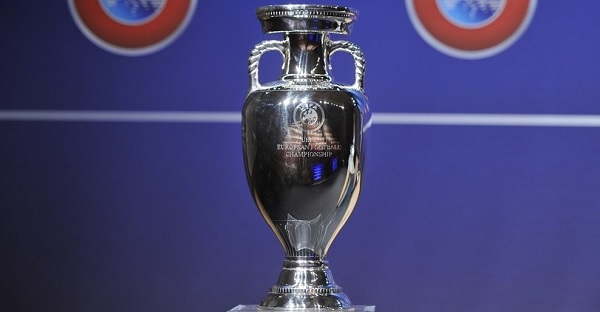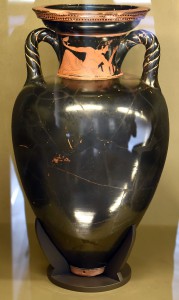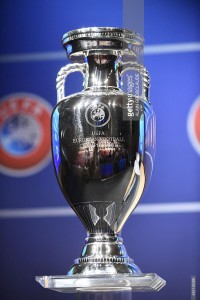
June 24, 2016, by Oliver Thomas
Euphronios and EURO 2016
What does the European Football Championship have to do with Greek art? Andreas Kropp has been tuning in…
Britain is Brexiting, Europe is reeling, and we can’t even begin to comprehend what just hit us. So how about this, let’s instead just focus our attention on that other thing gripping the continent these days, one that is conveniently pleasant and narcotic – footie! The EURO 2016 is in full swing, the greatest celebration of the most important of the unimportant things in life, at least until the next world cup comes around.
Of course, this tournament, like all tournaments, requires your participation. Avid viewers know that they cannot watch matches unprepared. A football fanatic needs to have a fixtures chart at the ready, waiting to be pencilled in with scores and tables. I got mine from a German tabloid (don’t ask). I like it because it’s plain and printer-friendly, with white boxes for fixtures and tables on a blue background, no fancy graphics. It does have one photo, though. In the bottom right corner, it has the gleaming silver cup, the ultimate prize for four weeks of simulated warfare on the green pitch.
No-one ever looks much at these trophies, right? I don’t either, except something about this shiny silver pot drew my eye. Funny, I thought, an amphora! And those odd braided handles, they remind me of something. And then it hit me.
 It’s like that amphora I always show in first-year lectures on Greek vase painting (see photo)! Lecture 10, “Red-Figure Vases” in Q81ART Interpreting Ancient Art in autumn terms, to be specific. This red-figure neck amphora found in Vulci (Etruria), 47 cm high, dated c. 510 BC, is now in the Louvre (see full record at the Beazley Archive). It is ascribed to Euphronios, one of the “pioneers” of early red-figure painting, best known for large-scale works such as a krater depicting a wrestling match between Herakles and Antaios.
It’s like that amphora I always show in first-year lectures on Greek vase painting (see photo)! Lecture 10, “Red-Figure Vases” in Q81ART Interpreting Ancient Art in autumn terms, to be specific. This red-figure neck amphora found in Vulci (Etruria), 47 cm high, dated c. 510 BC, is now in the Louvre (see full record at the Beazley Archive). It is ascribed to Euphronios, one of the “pioneers” of early red-figure painting, best known for large-scale works such as a krater depicting a wrestling match between Herakles and Antaios.
On the amphora, rather unusually, only the neck bears a figural scene. It shows a reclining banqueter with a wreath on his head holding his skyphos (drinking cup) with only the index finger of his right hand, playing a popular drinking game (kottabos). The inscription informs us that this man “Leagros is handsome” (Leagros kalos). His head is turned sharply to the right, presumably towards his companion on the other side of the vase’s neck, a fellow reveller playing the lyre. It is a reminder of what luxury vessels such as this one were destined for, as showpieces at symposia.
 Seen side by side, the parallels with the EURO cup are glaring. The shape and proportions; the tapering lower body; the bulge at the shoulders; the almost cylindrical neck separated from the belly by a torus; the twisted handles. The silver trophy is not merely inspired by an Attic amphora, it is a neck amphora with twisted handles. This is not to say that it is a copy of Euphronios’ piece (note e.g. the pointed foot). Neck amphoras with twisted handles, though not exactly frequent, were also made by Euphronios’ contemporaries and successors down to the fourth century BC. Some later pieces share further similarities with the silver cup, such as the tongue-patterns on the shoulders and the bottom end of the body (some examples in the BM and in the Met in NY). While all these features were adapted from Classical prototypes by the creators of the trophy, they gave it a conical foot and a lip with an angular bottom edge, features that are not found in Greek amphoras and that give it a more monumental appearance.
Seen side by side, the parallels with the EURO cup are glaring. The shape and proportions; the tapering lower body; the bulge at the shoulders; the almost cylindrical neck separated from the belly by a torus; the twisted handles. The silver trophy is not merely inspired by an Attic amphora, it is a neck amphora with twisted handles. This is not to say that it is a copy of Euphronios’ piece (note e.g. the pointed foot). Neck amphoras with twisted handles, though not exactly frequent, were also made by Euphronios’ contemporaries and successors down to the fourth century BC. Some later pieces share further similarities with the silver cup, such as the tongue-patterns on the shoulders and the bottom end of the body (some examples in the BM and in the Met in NY). While all these features were adapted from Classical prototypes by the creators of the trophy, they gave it a conical foot and a lip with an angular bottom edge, features that are not found in Greek amphoras and that give it a more monumental appearance.
Much to my surprise, a trawl through the internet did not yield any meaningful discussion of the trophy’s obvious roots in Greek prototypes. The terse sentence “This looks … rather like a neck-amphora” posted on a University of Kentucky Classics mailing list in 2004 is literally the internet’s most profound statement on this matter. In fact, it is hard to come by any information on the creation of the EURO trophy beyond a few bare facts (see e.g. UEFA). The original cup was made in 1960 and named after Henri Delaunay, UEFA’s first general secretary. For the EURO 2008, an updated version was created, 18cm higher (60 cm) and 2kg heavier than the original. Unlike the original, which was the work of the goldsmith Chobillon and bought by Arthus-Bertrand in Paris, the making of the modern equivalent was entrusted to Asprey in London. Where did the inspiration for the design come from? What were the models? What ideas was this remake of an Attic amphora meant to convey? Crickets. Contrast this with the deluge of content thrown up on and around EURO 2016. Everything about this tournament is divulged and dissected down to the last trivial detail (you seen the one about Irish fans helping a French driver with a flat tyre? About Ronaldo throwing a reporter’s microphone into a river!?) – and yet, there is no documentation of the creative process behind the Delaunay cup out there, nor even an unequivocal acknowledgement of its Athenian pedigree.
As you watch the matches at EURO 2016, you see the trophy countless times. With every slow-motion replay, a drawing of the cup pops up as a white silhouette in a red-white circle. When you watch it swoosh across your screen, please stop and ponder this mute tribute to the Athenian creative genius embodied by this silver pot. And quietly deplore the unfortunate fact that this piece of reception history goes unnoticed and unacknowledged. UEFA won’t tell the public about its trophy’s debt of gratitude to Athens’ finest potters and painters, and sadly Euphronios and consorts aren’t here to sue for copyright violations.
So here is a small remedy: When, finally, on 10 July you’ll watch the winners (France? Germany? England!?) lift the trophy into the Paris night sky, raise your kantharos to Euphronios! Or shed a thought at least. He’s deserved it.
Image credits (used under principles of fair use):
Banner and left: (c) Getty Images via UEFA website.
Right: Louvre G30. Image (c) Andreas Kropp.
No comments yet, fill out a comment to be the first

Leave a Reply